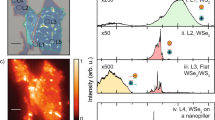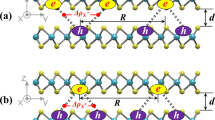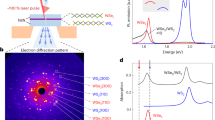Abstract
Heterostructures of atomically thin van der Waals bonded monolayers have opened a unique platform to engineer Coulomb correlations, shaping excitonic1,2,3, Mott insulating4 or superconducting phases5,6. In transition metal dichalcogenide heterostructures7, electrons and holes residing in different monolayers can bind into spatially indirect excitons1,3,8,9,10,11 with a strong potential for optoelectronics11,12, valleytronics1,3,13, Bose condensation14, superfluidity14,15 and moiré-induced nanodot lattices16. Yet these ideas require a microscopic understanding of the formation, dissociation and thermalization dynamics of correlations including ultrafast phase transitions. Here we introduce a direct ultrafast access to Coulomb correlations between monolayers, where phase-locked mid-infrared pulses allow us to measure the binding energy of interlayer excitons in WSe2/WS2 hetero-bilayers by revealing a novel 1s–2p resonance, explained by a fully quantum mechanical model. Furthermore, we trace, with subcycle time resolution, the transformation of an exciton gas photogenerated in the WSe2 layer directly into interlayer excitons. Depending on the stacking angle, intra- and interlayer species coexist on picosecond scales and the 1s–2p resonance becomes renormalized. Our work provides a direct measurement of the binding energy of interlayer excitons and opens the possibility to trace and control correlations in novel artificial materials.
This is a preview of subscription content, access via your institution
Access options
Access Nature and 54 other Nature Portfolio journals
Get Nature+, our best-value online-access subscription
$29.99 / 30 days
cancel any time
Subscribe to this journal
Receive 12 print issues and online access
$259.00 per year
only $21.58 per issue
Buy this article
- Purchase on Springer Link
- Instant access to full article PDF
Prices may be subject to local taxes which are calculated during checkout




Similar content being viewed by others
Data availability
The data sets generated during and/or analysed during the current study are available from the corresponding author upon reasonable request.
References
Rivera, P. et al. Valley-polarized exciton dynamics in a 2D semiconductor heterostructure. Science 351, 688–691 (2016).
Ju, L. et al. Tunable excitons in bilayer graphene. Science 358, 907–910 (2017).
Jin, C. et al. Imaging of pure spin-valley diffusion current in WS2–WSe2 heterostructures. Science 360, 893–896 (2018).
Cao, Y. et al. Correlated insulator behaviour at half-filling in magic-angle graphene superlattices. Nature 556, 80–84 (2018).
Cao, Y. et al. Unconventional superconductivity in magic-angle graphene superlattices. Nature 556, 43–50 (2018).
Lee, J. J. et al. Interfacial mode coupling as the origin of the enhancement of T c in FeSe films on SrTiO3. Nature 515, 245–248 (2014).
Gong, Y. et al. Vertical and in-plane heterostructures from WS2/MoS2 monolayers. Nat. Mater. 13, 1135–1142 (2014).
Hong, X. et al. Ultrafast charge transfer in atomically thin MoS2/WS2 heterostructures. Nat. Nanotechnol. 9, 682–686 (2014).
Rivera, P. et al. Observation of long-lived interlayer excitons in monolayer MoSe2–WSe2 heterostructures. Nat. Commun. 6, 6242 (2015).
Arora, A. et al. Interlayer excitons in a bulk van der Waals semiconductor. Nat. Commun. 8, 639 (2017).
Ross, J. S. et al. Interlayer exciton optoelectronics in a 2D heterostructure p–n junction. Nano Lett. 17, 638–643 (2017).
Unuchek, D. et al. Room-temperature electrical control of exciton flux in a van der Waals heterostructure. Nature 560, 340–344 (2018).
Baranowski, M. et al. Probing the interlayer exciton physics in a MoS2/MoSe2/MoS2 van der Waals heterostructure. Nano Lett. 17, 6360–6366 (2017).
Su, J.-J. & MacDonald, A. H. How to make a bilayer exciton condensate flow. Nat. Phys. 4, 799–802 (2008).
Fogler, M. M., Butov, L. V. & Novoselov, K. S. High-temperature superfluidity with indirect excitons in van der Waals heterostructures. Nat. Commun. 5, 4555 (2014).
Yu, H., Liu, G.-B., Tang, J., Xu, X. & Yao, W. Moiré excitons: from programmable quantum emitter arrays to spin–orbit-coupled artificial lattices. Sci. Adv. 3, e1701696 (2017).
Ugeda, M. M. et al. Giant band gap renormalization and excitonic effects in a monolayer transition metal dichalcogenide semiconductor. Nat. Mater. 13, 1091–1095 (2014).
Chernikov, A. et al. Exciton binding energy and nonhydrogenic Rydberg series in monolayer WS2. Phys. Rev. Lett. 113, 076802 (2014).
Poellmann, C. et al. Resonant internal quantum transitions and femtosecond radiative decay of excitons in monolayer WSe2. Nat. Mater. 14, 889–893 (2015).
Steinleitner, P. et al. Dielectric engineering of electronic correlations in a van der Waals heterostructure. Nano Lett. 18, 1402–1409 (2018).
Chen, H. et al. Ultrafast formation of interlayer hot excitons in atomically thin MoS2/WS2 heterostructures. Nat. Commun. 7, 12512 (2016).
Miller, B. et al. Long-lived direct and indirect interlayer excitons in van der Waals heterostructures. Nano Lett. 17, 5229–5237 (2017).
Kunstmann, J. et al. Momentum-space indirect interlayer excitons in transition-metal dichalcogenide van der Waals heterostructures. Nat. Phys. 14, 801–805 (2018).
Mounet, N. et al. Two-dimensional materials from high-throughput computational exfoliation of experimentally known compounds. Nat. Nanotechnol. 13, 246–252 (2018).
Huber, R. et al. How many-particle interactions develop after ultrafast excitation of an electron-hole plasma. Nature 414, 286–289 (2001).
Kaindl, R. A., Carnahan, M. A., Hägele, D., Lövenich, R. & Chemla, D. S. Ultrafast terahertz probes of transient conducting and insulating phases in an electron–hole gas. Nature 423, 734–738 (2003).
Luo, L. et al. Ultrafast terahertz snapshots of excitonic Rydberg states and electronic coherence in an organometal halide perovskite. Nat. Commun. 8, 15565 (2017).
Ulbricht, R., Hendry, E., Shan, J., Heinz, T. F. & Bonn, M. Carrier dynamics in semiconductors studied with time-resolved terahertz spectroscopy. Rev. Mod. Phys. 83, 543 (2011).
Wang, K. et al. Interlayer coupling in twisted WSe2/WS2 bilayer heterostructures revealed by optical spectroscopy. ACS Nano 10, 6612–6622 (2016).
Brem, S., Selig, M., Berghaeuser, G. & Malic, E. Exciton relaxation cascade in two-dimensional transition metal dichalcogenides. Sci. Rep. 8, 8238 (2018).
Castellanos-Gomez, A. et al. Deterministic transfer of two-dimensional materials by all-dry viscoelastic stamping. 2D Mater. 1, 011002 (2014).
Leandro, M. et al. Observation of intense second harmonic generation from MoS2 atomic crystals. Phys. Rev. B 87, 201401 (2014).
Berghäuser, G. et al. Mapping of the dark exciton landscape in transition metal dichalcogenides. Phys. Rev. B 98, 020301 (2018).
Laturia, A., Van de Put, M. & Vandenberghe, W. Dielectric properties of hexagonal boron nitride and transition metal dichalcogenides: from monolayer to bulk. NPJ 2D Mater. Appl. 2, 6 (2018).
Berkelbach, T., Hybertsen, M. & Reichman, D. Theory of neutral and charged excitons in monolayer transition dichalcogenides. Phys. Rev. B 88, 045318 (2013).
Kormányos, A. et al. k·p theory for two-dimensional transition metal dichalcogenide semiconductors. 2D Mater. 2, 022001 (2015).
Ovesen, S. et al. Interlayer exciton dynamics in van der Waals heterostructures. Commun. Phys. 2, 23 (2019).
Selig, M. et al. Dark and bright exciton formation, thermalization, and photoluminescence in monolayer transtion metal dichalcogenides. 2D Mater. 5, 035017 (2018).
Yankowitz, M. et al. Emergence of superlattice Dirac points in graphene on hexagonal boron nitride. Nat. Phys. 8, 382–386 (2012).
Acknowledgements
The authors thank M. Furthmeier for technical assistance. This work was supported by the Deutsche Forschungsgemeinschaft (DFG) through research training group GRK 1570, Collaborative Research Center SFB 1277 (projects A05 and B03) and project grant KO3612/3-1. The Chalmers group acknowledges funding from the European Union’s Horizon 2020 research and innovation programme under grant agreement no. 696656 (Graphene Flagship) and the Swedish Research Council (VR).
Author information
Authors and Affiliations
Contributions
R.H. and E.M. supervised the study. P.M., F.M., P.S., A.G. and R.H. carried out the experiments. P.S., P.M., F.M., A.G., K.-Q.L., P.N., J.H., C.S., J.M.L. and T.K. prepared and pre-characterized the large-area heterostructures. S.O., S.B. and E.M. carried out the theoretical modelling. All authors analysed the data, discussed the results and contributed to the writing of the manuscript.
Corresponding authors
Ethics declarations
Competing interests
The authors declare no competing interests.
Additional information
Publisher’s note: Springer Nature remains neutral with regard to jurisdictional claims in published maps and institutional affiliations.
Supplementary information
Supplementary Information
Supplementary Sections 1–6, Supplementary Figs. 1–6, Supplementary references 1–4.
Rights and permissions
About this article
Cite this article
Merkl, P., Mooshammer, F., Steinleitner, P. et al. Ultrafast transition between exciton phases in van der Waals heterostructures. Nat. Mater. 18, 691–696 (2019). https://doi.org/10.1038/s41563-019-0337-0
Received:
Accepted:
Published:
Issue Date:
DOI: https://doi.org/10.1038/s41563-019-0337-0
This article is cited by
-
Excitonic devices based on two-dimensional transition metal dichalcogenides van der Waals heterostructures
Frontiers of Chemical Science and Engineering (2024)
-
Twistronics and moiré excitonic physics in van der Waals heterostructures
Frontiers of Physics (2024)
-
Spin-polarized spatially indirect excitons in a topological insulator
Nature (2023)
-
Localization and interaction of interlayer excitons in MoSe2/WSe2 heterobilayers
Nature Communications (2023)
-
Time-domain observation of interlayer exciton formation and thermalization in a MoSe2/WSe2 heterostructure
Nature Communications (2023)



